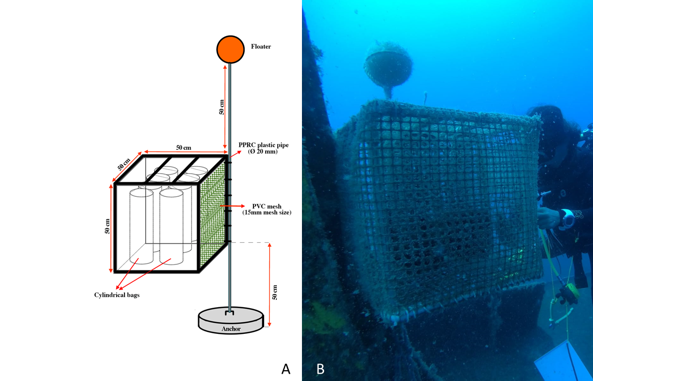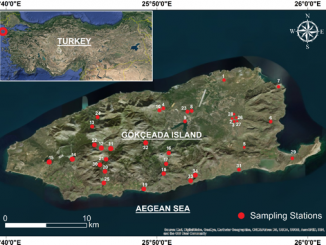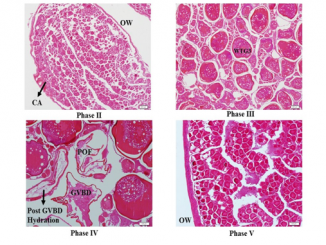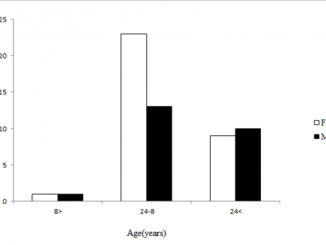
Paper category: Original research paper
Corresponding author: Tuğçe Şensurat-Genç (sensurat@gmail.com)
DOI: 10.2478/oandhs-2021-0038
Received: 18/05/2021
Accepted: 16/07/2021
Full text: here
Citation (APA style): Şensurat-Genç,T.,Karadal,O.,Oruç,A.,Özgül,A. & Lök,A.(2021).Effects of seasonal changes and depth on growth parameters of the Mediterranean mussel (Mytilus galloprovincialis) on a shipwreck in the Eastern Mediterranean Sea. Oceanological and Hydrobiological Studies,50(4) 441-454. https://doi.org/10.2478/oandhs-2021-0038
Abstract
The study was conducted between July 2018 and May 2020 to compare seasonal changes in growth parameters of the Mediterranean mussel (Mytilus galloprovincialis) at different depths in two different areas of the Northeastern Mediterranean Sea (Aegean Sea). In a preliminary study, mussels were placed in cages at different depths of an artificial reef (AR – shipwreck) and natural reef (NR). Temperature, salinity, pH, and dissolved oxygen were determined seasonally at both sites at a depth of 37 m (deepwater) and 25 m (midwater). Linear increases in length and width of mussels at the AR site were recorded, while no consistent changes were observed for mussels at the NR. There was negative correlation between the specific growth rate (SGR) and salinity (r<sub>2</sub> = 0.5098) and temperature (r<sub>2</sub> = 0.1470) at the AR site. Negative correlations were also recorded between pH and the commercial condition index (CCI) at both the AR (r<sub>2</sub> = 0.3869) and NR (r<sub>2</sub> = 0.3600) sites. Our findings show that depth had a significant effect (p < 0.05) on the CCI of mussels at the NR site, while its effect was insignificant for this index at the AR site (p > 0.05). This study indicates that natural reefs provide more suitable conditions for the growth of Mediterranean mussels than shipwrecks used as artificial reefs.
Acknowledgements
This work was supported by the Scientific and Technological Research Council of Turkey-TÜBİTAK (Grant No. 117Y033). The authors would especially like to thank Hamdullah Aras for his assistance with field logistics and Erdal Songür from İzmir Directorate of Provincial Agriculture and Forestry for supplying information on fish farm data. Many thanks are also due to Darryl T. for language editing and proofreading. We are grateful to the anonymous reviewers whose comments improved this manuscript.
References
Ardizzone, G.D., Gravina, M.F. & Belluscio, A. (1989). Temporal development of epibenthic communities on artificial reefs in the central Mediterranean Sea. Bull. Mar. Sci. 350 44(2): 592–608.
Ardizzone, G.D., Belluscio, A., Gravina, M.F. & Somaschini, A. (1996). Colonization and disappearance of Mytilus galloprovincialis Lam. on an artificial habitat in the Mediterranean Sea. Estuar. Coast. Shelf Sci. 43(6): 665–676. DOI: 10.1006/ecss.1996.0095.
Bamber, N.R. (1990). The effects of acidic sea water on three species of lamellibranch molluscs. J. Exp. Mar. Biol. Ecol. 143(3): 181–191. DOI: 10.1016/0022-0981(90)90069-O.
Bayne, B.L. & Newell, R.C. (1983). Physiological energetics of marine molluscs. In A.S.M. Saleuddin & K.M. Wilbur (Eds.), The mollusca (pp. 407–515). Cambridge, UK.
Blanchette, C.A., Helmuth, B. & Gaines, S.D. (2007). Spatial patterns of growth in the mussel, Mytilus californianus, across a major oceanographic and biogeographic boundary at Point Conception, California, USA. J. Exp. Mar. Biol. Ecol. 340(2): 126–148. DOI: 10.1016/j.jembe.2006.09.022.
Borg, J.A., Magro, M. & Schembri, P.J. (2005). Reef colonization study: photographic monitoring session March - May 2005 (Interim report). Marine Ecology Research Group (MERG): Department of Biology, University of Malta.
Bortone, S. (2006). A perspective of artificial reef research: the past, present, and future. Bull. Mar. Sci. 78(1): 1–8.
Cajaraville, M.P., Bebianno, M.J., Blasco, J., Porte, C., Sarasquete, C. et al. (2000). The use of biomarkers to assess the impact of pollution in coastal environments of the Iberian Peninsula: a practical approach. Sci. Total. Environ. 247(2–3): 295–311. DOI: 10.1016/S0048-9697(99)00499-4.
Carballal, M.J., Villalba, A. & López, C. (1998). Seasonal variation and effects of age, food availability, size, gonadal development, and parasitism on the hemogram of Mytilus galloprovincialis. J. Invertebr. Pathol. 72(3): 304–312. DOI: 10.1006/jipa.1998.4779.
Consoli, P., Martino, A., Romeo, T., Sinopoli, M., Perzia, P. et al. (2015). The effect of shipwrecks on associated fish assemblages in the central Mediterranean Sea. J. Mar. Biol. Assoc. U. K. 95(1): 17–24. DOI: 10.1017/S0025315414000940.
Çelik, M.Y., Karayücel, S., Karayücel, İ., Eyüboğlu, B. & Öztürk, R. (2015). Settlement and growth of the mussels (Mytilus galloprovincialis, Lamarck, 1819) on different collectors suspended from an offshore submerged longline system in the Black Sea. Aquac. Res. 47(12): 3765–3776. DOI: 10.1111/are.12827.
Fabi, G., Fiorentini, L. & Giannini, S. (1989). Experimental shellfish culture on an artificial reef in the Adriatic Sea. Bull. Mar. Sci. 44(2): 923–933.
Fabi, G., Scarcella, G., Spagnolo, A., Bortone, S.A., Charbonnel, E. et al. (2015). Practical guidelines for the use of artificial reefs in the Mediterranean and the Black Sea (Issue 96). General Fisheries Commission for the Mediterranean. Studies and Reviews, Rome.
Fabi, G., Spagnolo, A., Bellan-Santini, D., Charbonnel, E., Çiçek, B.A. et al. (2011). Overview on artificial reefs in Europe. Braz. J. Oceanogr. 59(1): 155–156.
FAO. (2017). Cultured aquatic species information programme: Mytilus edulis. Food and Agriculture Organization. www.fao.org/fishery/culturedspecies/Mytilus_edulis/en.
Freitas, R., de Marchi, L., Bastos, M., Moreira, A., Velez, C. et al. (2017). Effects of seawater acidification and salinity alterations on metabolic, osmoregulation and oxidative stress markers in Mytilus galloprovincialis. Ecol. Indic. 79: 54–62. DOI: 10.1016/j.ecolind.2017.04.003.
Galgani, F., Chiffoleau, J.F., Gall, P.L., Pichot, Y., Andral, B. et al. (2005). Deep-sea caging of the mussel Mytilus galloprovincialis: Potential application in ecotoxicological studies. Chem. Ecol. 21(2): 133–141. DOI: 10.1080/02757540500093048.
Garen, P., Robert, S. & Bougrier, S. (2004). Comparison of growth of mussel, Mytilus edulis, on longline, pole and bottom culture sites in the Pertuis Breton, France. Aquaculture 232(1-4): 511–524. DOI: 10.1016/S0044-8486(03)00535-0.
Gedik, K. & Eryaşar, A.R. (2020). Microplastic pollution profile of Mediterranean mussels (Mytilus galloprovincialis) collected along the Turkish coast. Chemosphere 260: 127570. DOI: 10.1016/j.chemosphere.2020.127570.
Goldberg, E.D. & Bertine, K.K. (2000). Beyond the mussel watch – new directions for monitoring marine pollution. Sci. Tot. Environ. 247(2–3): 165–174. DOI: 10.1016/S0048-9697(99)00488-X.
Gvozdenović, S., Mandić, M. & Peraš, I. (2020). Morphometry and condition index in Mediterranean mussel (Mytilus galloprovincialis Lamarck, 1819) from Boka Kotorska Bay (Montenegro, southeast Adriatic Sea). Stud. Mar. 33(2): 15–26.
Hamer, B., Jakšić, Ž., Pavičić-Hamer, D., Perić, L., Medaković, D. et al. (2008). Effect of hypoosmotic stress by low salinity acclimation of Mediterranean mussels Mytilus galloprovincialis on biological parameters used for pollution assessment. Aquat. Toxicol. 89(3): 137–151. DOI: 10.1016/j.aquatox.2008.06.015.
Hickman, R.W. & Illingworth, J. (1980). Condition cycle of the green-lipped mussel Perna canaliculus in New Zealand. Mar. Biol. 60(1): 27–38. DOI: 10.1007/BF00395603.
ICRAM. (2007). Development of European Guidelines for Potential Polluting Shipwrecks (D.E.E.P.P.) Project.
Irisarri, J., Fernández-Reiriz, M.J. & Labarta, U. (2015). Temporal and spatial variations in proximate composition and Condition Index of mussels Mytilus galloprovincialis cultured in suspension in a shellfish farm. Aquaculture 435: 207–216. DOI: 10.1016/j.aquaculture.2014.09.041.
Ito, Y. (2011). Artificial reef function in fishing grounds off Japan. In S.A. Bortone, F.P. Brandi, G. Fabi & S. Otake (Eds.), Artificial reefs in fisheries management (pp. 239–264). Boca Raton, Florida.
İzmir DPAF. (2019). Republic of Turkey Ministry of Agriculture and Forestry, İzmir Directorate of Provincial Agriculture and Forestry.
Jimenez, C., Andreou, V., Evriviadou, M., Munkes, B., Hadjioannou, L. et al. (2017). Epibenthic communities associated with unintentional artificial reefs (modern shipwrecks) under contrasting regimes of nutrients in the Levantine Sea (Cyprus and Lebanon). PLoS One 12(8): e0182486. DOI: 10.1371/journal.pone.0182486.
Jones, R.S. & Thomson, M.J. (1978). Comparison of Florida reef fish assemblages using a rapid visual technique. Bull. Mar. Sci. 28(1): 159–172.
Kapranov, S.V., Kovrigina, N.P., Troshchenko, O.A. & Rodionova, N.Y. (2020). Long-term variations of thermohaline and hydrochemical characteristics in the mussel farm area in the coastal waters off Sevastopol (Black Sea) in 2001–2018. Cont. Shelf Res. 206: 104185. DOI: 10.1016/j.csr.2020.104185.
Karayücel, S., Çelik, M.Y., Karayücel, İ. & Erik, G. (2010). Growth and production of raft cultivated Mediterranean mussel (Mytilus galloprovincialis Lamarck, 1819) in Sinop, Black sea. Turk. J. Fish. Aquat. Sci.10(1): 9–17. DOI: 10.4194/trjfas.2010.0102.
Kayhan, F.E., Balkis, N., Aksu, A., Yon Ertug, N.D. & Sesal, C. (2016). Trace metal concentration and sea water quality of Tuzla Shipyard Area, Istanbul, Turkey using Mediterranean mussels (Mytilus galloprovincialis) for monitoring aquatic pollution. Pak. J. Zool. 48(2): 597–600.
Keskin, İ. & Ekici, A. (2021). Effects of environmental factors and food availability in Northern Aegean sea on the cultivation of Mediterranean mussels (Mytilus galloprovincialis). Aquacu. Res. 52(1): 65–76. DOI: 10.1111/are.14870.
Klaoudatos, D.S., Anastasopoulou, A., Papaconstantinou, C. & Conides, A.I. (2012). The Greek experience of artificial reef construction and management. J. Environ. Prot. Ecol. 13(3A): 1647–1655.
Kovačić, I., Pavičić-Hamer, D., Kanduč, T. & Hamer, B. (2017). Adaptation of cultured mussel Mytilus galloprovincialis Lamarck, 1819 from the northern Adriatic Sea to nearby aquaculture sites and translocation. Acta Adriat. 58(2): 285–296.
Kumlu, M. (2001). Shrimp, lobster and mussel farming. Çukurova University Faculty of Fisheries Press, Adana.
Lima, J.S., Zalmon, I.R. & Love, M. (2019). Overview and trends of ecological and socioeconomic research on artificial reefs. Mar. Environ. Res. 145: 81–96. DOI: 10.1016/j.marenvres.2019.01.010.
Lindberg, W.J. & Seaman, W. (2011). Guidelines and management practices for artificial reef siting, use, construction, and anchoring in Southeast Florida. Florida Department of Environmental Protection: Miami, FL.
Lök, A. (2001). Growth rate of different size groups of mussels, Mytilus galloprovincialis Lamarck, 1819 in Iskele-Urla (Bay of Izmir). EgeJFAS 18(1–2): 141–147.
Lök, A., Acarlı, S., Serdar, S., Köse, A. & Yıldız, H. (2007). Growth and mortality of Mediterranean mussel Mytilus galloprovincialis Lam., 1819, in relation to size on longline in Mersin Bay, Izmir (Turkey-Aegean Sea). Aquac. Res. 38(8): 819–826. DOI: 10.1111/j.1365-2109.2007.01717.x.
Lök, A., Gül, B., Ulas, A., Düzbastılar, F.O. & Metin, C. (2008). Diel variations on the fish assemblages at artificial reefs in two different environments of the Aegean Sea (Western Coast of Turkey). Turk. J. Fish. Acuat. Sci. 8(1): 79–85.
Malak, D.A., Livingstone, S.R., Pollard, D., Polidoro, B.A., Cuttelod, A. et al. (2011). Overview of the conservation status of the marine fishes of the Mediterranean Sea. IUCN, Gland, Switzerland and Malaga, Spain.
Massin, C., Norro, A. & Mallefet, J. (2002). Biodiversity of a wreck from the Belgian Continental Shelf: monitoring using scientific diving: preliminary results. Bulletin van het Koninklijk Belgisch Instituut voor Natuurwetenschappen-Biologie 72: 67–72.
Michaelidis, B., Ouzounis, C., Paleras, A. & Pörtner, H.O. (2005). Effects of long-term moderate hypercapnia on acid–base balance and growth rate in marine mussels Mytilus galloprovincialis. Mar. Ecol Prog. Ser. 293: 109–118. DOI: 10.3354/meps293109.
Oh, C.O., Ditton, R.B. & Stoll, J.R. (2008). The economic value of scuba-diving use of natural and artificial reef habitats. Soc. Nat. Resour. 21(6): 455–468. DOI: 10.1080/08941920701681953.
Okumuş, İ. (1993). Evaluation of suspended mussel (Mytilus edulis L) culture and integrated experimental mariculture (salmon-mussel) trials in Scottish Sea Lochs. Doctoral dissertation, University of Stirling, UK.
Orban, E., Di Lena, G., Nevigato, T., Casini, I., Marzetti, A. et al. (2002). Seasonal changes in meat content, condition index and chemical composition of mussels (Mytilus galloprovincialis) cultured in two different Italian sites. Food Chem. 77(1): 57–65. DOI: 10.1016/S0308- 8146(01)00322-3.
Parisi, G., Giorgi, G., Messini, A. & Poli, B.M. (2005). Growth performance and quality traits of mussel (Mytilus galloprovincialis Lamarck) reared in two different sites in Tuscany. Ital. J. Anim. Sci. 4(sup2): 612–614. DOI: 10.4081/ijas.2005.2s.612.
Pavičić Hamer, D., Kovačić, I., Koščica, L. & Hamer, B. (2016). Physiological indices of maricultured mussel Mytilus galloprovincialis Lamarck, 1819 in Istria, Croatia: Seasonal and transplantation effect. J. World Aquac. Soc. 47(6): 768–778. DOI: 10.1111/jwas.12316.
Peharda, M., Župan, I., Bavčević, L., Frankić, A. & Klanjs̆ček, T. (2007). Growth and condition index of mussel Mytilus galloprovincialis in experimental integrated aquaculture. Aquac. Res. 38(16): 1714–1720. DOI: 10.1111/j.1365-2109.2007.01840.x.
Perkol-Finkel, S. & Benayahu, Y. (2007). Differential recruitment of benthic communities on neighboring artificial and natural reefs. J. Exp. Mar. Biol. Ecol. 340(1): 25–39. DOI: 10.1016/j.jembe.2006.08.008.
Polak, O. & Shashar, N. (2012). Can a small artificial reef reduce diving pressure from a natural coral reef? Lessons learned from Eilat, Red Sea. Ocean Coast. Manage. 55: 94–100. DOI: 10.1016/j.ocecoaman.2011.10.006.
Prins, T.C., Escaravage, V., Smaal, A.C. & Peeters, J.C.H. (1995). Nutrient cycling and phytoplankton dynamics in relation to mussel grazing in a mesocosm experiment. Ophelia 41: 289–315. DOI: 10.1080/00785236.1995.10422049.
Quinn, R. (2006). The role of scour in shipwreck site formation processes and the preservation of wreck-associated scour signatures in the sedimentary record – evidence from seabed and sub-surface data. J. Archaeol. Sci. 33(10): 1419–1432. DOI: 10.1016/j.jas.2006.01.011.
Renzi, M., Romeo, T., Guerranti, C., Perra, G., Canese, S. et al. (2017). Are shipwrecks a real hazard for the ecosystem in the Mediterranean Sea? Mar. Poll. Bull. 124(1): 21–32. DOI: 10.1016/j.marpolbul.2017.06.084.
Renzoni, A. (1963). Ricerche ecologiche ed idrobiologiche su Mytilus galloprovincialis Lam. Nel Golfo di Napoli. Bollettino di Pesca Piscicoltura e Idrobiologia 18: 187–227.
Rouane-Hacene, O., Boutiba, Z., Belhaouari, B., Guibbolini-Sabatier, M.E., Francour, P. et al. (2015). Seasonal assessment of biological indices, bioaccumulation and bioavailability of heavy metals in mussels Mytilus galloprovincialis from Algerian west coast, applied to environmental monitoring. Oceanologia 57(4): 362–374. DOI: 10.1016/j.oceano.2015.07.004.
Ruuskanen, A.T., Kraufvelin, P., Alvik, R., Díaz, E.R., Honkonen, J. et al. (2015). Benthic conditions around a historic shipwreck: Vrouw Maria (1771) in the northern Baltic proper. Cont. Shelf Res. 98: 1–12. DOI: 10.1016/j.csr.2015.02.006.
Salomidi, M., Katsanevakis, S., Issaris, Y., Tsiamis, K. & Katsiaras, N. (2013). Anthropogenic disturbance of coastal habitats promotes the spread of the introduced scleractinian coral Oculina patagonica in the Mediterranean Sea. Biol. Invasions 15(9): 1961–1971. DOI: 10.1007/s10530-013-0424-0.
Sedano, F., Florido, M., Rallis, I., Espinosa, F. & Gerovasileiou, V. (2019). Comparing sessile benthos on shallow artificial versus natural hard substrates in the Eastern Mediterranean Sea. Med. Mar. Sci. 20(4): 688–702. DOI: 10.12681/mms.17897.
Seed, R. & Suchanek, T.H. (1992). Population and community ecology of Mytilus. In E. Gosling (Eds.), The mussel Mytilus: Ecology, physiology, genetics and culture (pp. 87–169). Elsevier Science Publishers, Amsterdam.
Shurova, N.M. (2001). Influence of salinity on the structure and the state of bivalve Mytilus galloprovincialis populations. Russ. J. Mar. Biol. 27(3): 151–155. DOI: 10.1023/A:1016713401707.
Sinis, A.I., Chintiroglou, C.C. & Stergiou, K.I. (2000). Preliminary results from the establishment of experimental artificial reefs in the N. Aegean Sea (Chalkidiki, Greece). Belg. J. Zool. 130(Supplement): 143–147.
Sinopoli, M., Consoli, P., Perzia, P., Romeo, T. & Andaloro, F. (2015). Distribution of fish fauna associated with a shipwreck in the southern Tyrrhenian Sea: vertical distribution and shipwreck structures. J. Appl. Ichthyol. 31(S3): 96–101. DOI: 10. 1111/jai.12954.
Sprovieri, M., Barra, M., Del Core, M., Di Martino, G., Gherardi, S. et al. (2013). Marine pollution from shipwrecks at the sea bottom: a case study from the Mediterranean Basin. In T.B. Hughes (Eds.), Mediterranean Sea: Ecosystems, economic importance and environmental threats (pp. 35–64). Nova Publishers, New York.
Sun, T., Tang, X., Zhou, B. & Wang, Y. (2016). Comparative studies on the effects of seawater acidification caused by CO2 and HCl enrichment on physiological changes in Mytilus edulis. Chemosphere 144: 2368–2376. DOI: 10.1016/j.chemosphere.2015.10.117.
Şensurat-Genç, T., Özgül, A. & Lök, A. (2017). The use of artificial reefs for recreational diving. Turk. J. Marit. Marine Sci. 3(1): 27–33.
Viarengo, A., Dondero, F., Pampanin, D.M., Fabbri, R., Poggi, E. et al. (2007). A biomonitoring study assessing the residual biological effects of pollution caused by the HAVEN wreck on marine organisms in the Ligurian sea (Italy). Arch. Environ. Contam. Toxicol. 53(4): 607–616. DOI: 10.1007/s00244-005-0209-2.
Walker, S.J., Schlacher, T.A. & Schlacher-Hoenlinger, M.A. (2007). Spatial heterogeneity of epibenthos on artificial reefs: fouling communities in the early stages of colonization on an East Australian shipwreck. Mar. Ecol. 28(4): 435–445. DOI: 10.1111/j.1439- 0485.2007.00193.x.
Yıldız, H., Acarlı, S., Berber, S., Vural, P. & Gündüz, F. (2013). A preliminary study on Mediterranean mussel (Mytilus galloprovincialis Lamarck, 1819) culture in integrated multitrofik aquaculture systems in Çanakkale Strait. Alinteri J. Agricult. Sci. 25(B): 38–44.
Yildiz, H., Palaz, M. & Bulut, M. (2006). Condition indices of Mediterranean mussels (Mytilus galloprovincialis L. 1819) growing on suspended ropes in Dardanelles. J. Food Technol. 4(3): 221–224.
Zar, J.H. (1999). Biostatistical analysis (4th Edition). Upper Saddle River, Prentice-Hall Inc.
Zenetos, A., Siokou-Frangou, I. & Gotsis-Skretas, O. (2002). Europe’s Biodiversity: biogeographical regions and seas. The Mediterranean Sea. European Environment Agency. http://www.eea.europa.eu/publications/report_2002_0524_154909.
Zintzen, V., Massin, C., Norro, A. & Mallefet, J. (2006). Epifaunal inventory of two shipwrecks from the Belgian Continental Shelf. Hydrobiologia 555: 207–219. DOI: 10.1007/s10750-005-1117-1.



